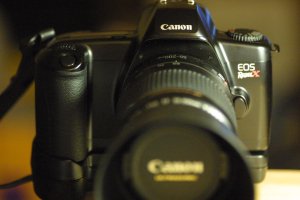My Experience with the Canon Rebel X
It has been a while since the last time I had used a Canon Rebel camera. If you read my review on the Canon Elan IIe camera you would have known that I passed on my prized Rebel G to my father. Over the last two years, I have missed the weight, or the lack of weight, of my Rebel G. I cannot begin to describe my joy when I found a Rebel X body on clearance at Best Buy for $69. It was a display model and everything seems to be working except for a portion of the LCD. I bought the four-year warranty ($20) so that I can get the camera fixed to spec.

It just so happens that I will be traveling to Phoenix, Arizona the week after. This camera body will be a great backup for my Elan IIe. The trip would be a great time to test out the camera.
On trips, I generally carry a Elan IIe body with a Canon 28-135mm f/3.5-5.6 IS USM lens and a Sigma 70-200 f/2.8 EX HSM lens. So for the Arizona trip, I mounted the Canon lens on the Elan IIe, then mounted the Sigma lens on the Rebel X. Both setups was able to fit in my backpack at the same time. I could not feel the extra weight of the Rebel X at all.
I shot one roll of film on the way to Phoenix. The test roll was immediately developed at Wal-Mart to make sure the camera works. Exposure was right on. I knew then that I have two good cameras to work with that week.

The Rebel X has the same three point focus as its replacement, the Rebel G. The Rebel X is slightly different than the Rebel G in that it does not allow manual selection of focus point, nor did it report the focus point in focus. When I first got my hands on the Rebel X a few years ago, I could not stand the fact that I cannot select the focus point and have to guess which point is in focus. I ended up selling my original Rebel X for a profit. However, during the Arizona trip I found that I have so much experience now with Canon equipment (5 years) that I can easily see which point is in focus and how to achieve focus on any of the three points. The Rebel X became very easy to use and I returned home with many publishable images.
The Rebel X includes the following mode: program, aperture priority, shutter priority, manual, A-DEP, full-auto, portrait, landscape, macro, and sport. I have never used any modes other than program, aperture priority, shutter priority, and manual on any of my cameras. It also supports timer and mid-roll rewind function. The exposure compensation is plus/minus 2 stops. The camera functions pretty much just like a Rebel G, so there is no surprise there.
One thing the Rebel X does not have is a flash. However, there is a flash hot-shoe. A sibling model, the Rebel XS, which functions exactly the same as the Rebel X, comes with a pop-up flash.
The clearance camera did not include any accessories, such as the strap. Since I was going to get a BP-8 battery grip for the camera anyway, I just used the hand strap that came with the battery grip. So far this camera has work very nicely for me on several trips. I look forward to taking it out again.
Related Links
136 Users Online
|
$10000-above $5000-$9999 $2000-$4999 $1000-$1999 $500-$999 $200-$499 $100-$199 $50-$99 $25-$49 $0-$24 Gift Certificate |
|




